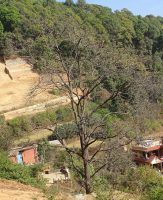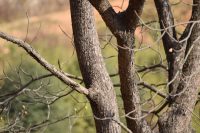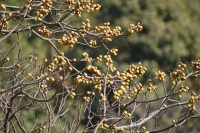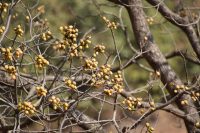|
Choerospondias axillaris (Roxb.) B.L.Burtt & A.W.Hill, Ann. Bot. (Oxford) n.s., 1: 254 1937. (syn: Choerospondias axillaris var. japonica (Ohwi) Ohwi; Poupartia axillaris (Roxb.) King & Prain; Poupartia fordii Hemsl.; Poupartia fordii var. japonica Ohwi ; Rhus bodinieri H. Lév.; Spondias axillaris Roxb.; Spondias lutea Engl.);
.
SE-Tibet, Taiwan, China (Yunnan, Guizhou, Guangxi, Guangdong, Hunan, Hubei, Jiangxi, Fujian, Zhejiang, Anhui), S-Japan, Cambodia, Japan (S-Kyushu), Laos, Vietnam, Nepal, Thailand, Bhutan, India (Assam, Darjeeling, West Bengal, Arunachal Pradesh, Meghalaya), Myanmar [Burma] (Kachin) as per Catalogue of Life
.
Choerospondias axillaris, known as Lapsi लप्सी in Nepali and Aamali आम्ली in Nepal Bhasa , also known in English as the “Nepali hog plum“, and nánsuānzǎo in Mandarin (Chinese: 南酸枣; literally: “southern sour date”), is a tree in the family Anacardiaceae. It is known as Lepchipoma in Assamese and in Bengal it is known as Amrda.”আমড়া“[citation needed] Its fruit is about 3 centimeters long and has a soft whitish sour flesh and green to yellow skin. The fruit is made into pickles, fruit tarts, and sour, spicy candy in Nepal. The tree has long been cultivated in rural Nepal for its fruit.[1] The fruit is nutritious and has a price comparable to the mandarin orange on the Nepalese market.[1]
This is a deciduous tree growing up to 20 meters tall. The smaller branches are purple-brown in color. The compound leaves are up to 40 cm (16 in) long and divided into 3 to 6 papery oval leaflets each up to 12 cm × 4.5 cm (4.7 in × 1.8 in).[2] The tree is dioecious, with male and female trees producing different types of inflorescence.[1] Male flowers occur in long clusters and have curving, brown-veined petals about 3 millimeters long. Female flowers are solitary in leaf axils at the tips of branches. They are larger than the male flowers and yield the edible drupe. The fallen fruits are consumed and dispersed by sambar and barking deer.[3][4]
Besides fruit, the tree yields valuable wood and hard seeds which are burned for fuel, and has parts used medicinally in Vietnam.[1]
Catechin-7-O-glucoside can be found in the stem barks of C. axillaris.[5]
(from Wikipedia on 17.10.16) . Choerospondias axillaris (Roxb.) B.L. Burtt & A.W. Hill (accepted name) : 1 post by 1 author. Attachments (5)
Sharing some pictures of Nepal’s specialty, Choerospondias axillaris (Roxb.) B.L. Burtt & A.W. Hill (accepted name) shot at Different locations on different dates at 4500 ft .
Common names :
Nepali Hog Plum
Nepali Name: Lapsi लप्सी To me appears more closer to images and details at This is 100. % Choerospondias axillaris (Roxb.) B.L. Burtt & A.W. Hill !
There may be a mix up of the two species. I have doubts about the last two.
Flora of China says: leaf blade 25-40 cm, imparipinnately compound, with 3-6 leaflets;
For Spondias pinnata (Linnaeus f.) Kurz, it says leaf blade 30-40 cm, imparipinnately compound with 5-11 opposite leaflets.
You are right … Looks like the last two images are mixed up from another file.
First 3 images are correct !
.
Location: Pharping, Kathmandu, Nepal
Altitude: 1593m.
Date: 20 December 2022
Habit : Wild
Yes, possible as per details at Flora of China.
|
Choerospondias axillaris
Updated on December 24, 2024






